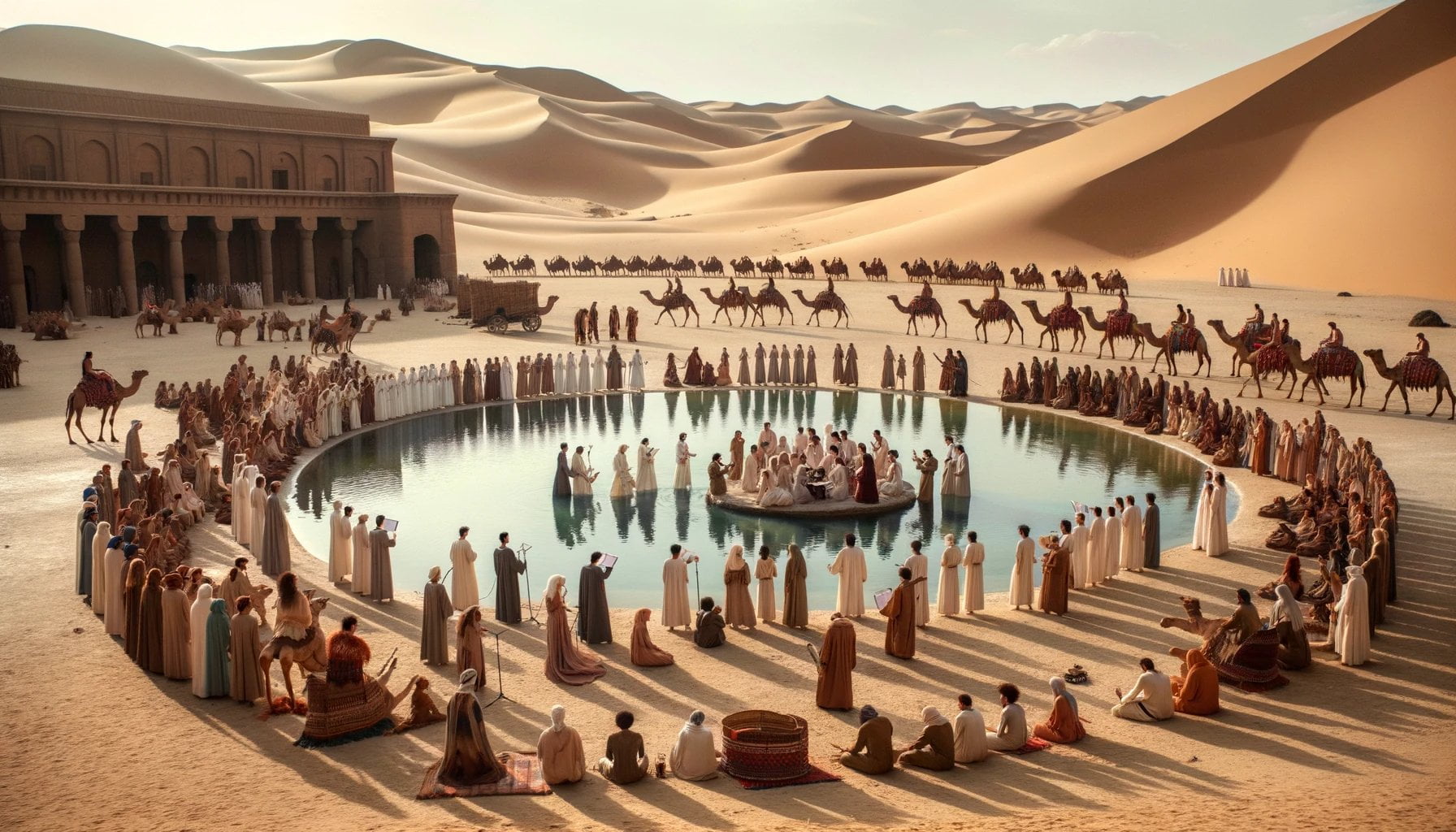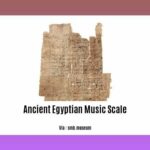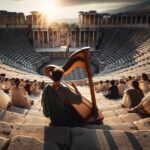Get ready to be transported through time and immerse yourself in the captivating world of musicals set in ancient Egypt. In our article [Echoes of Egypt: Unveiling the Splendor of Musicals Set in Ancient Egypt], we will delve into the mesmerizing realm of these theatrical productions, where history and music intertwine to create a truly enchanting experience. From the majestic pyramids to the opulent courts of pharaohs, these musicals bring to life the rich tapestry of ancient Egyptian culture and mythology. Join us as we explore the intricate composition, breathtaking choreography, and mesmerizing performances that make these musicals a feast for the senses. Prepare to uncover the hidden treasures of this captivating genre as we embark on this journey together.
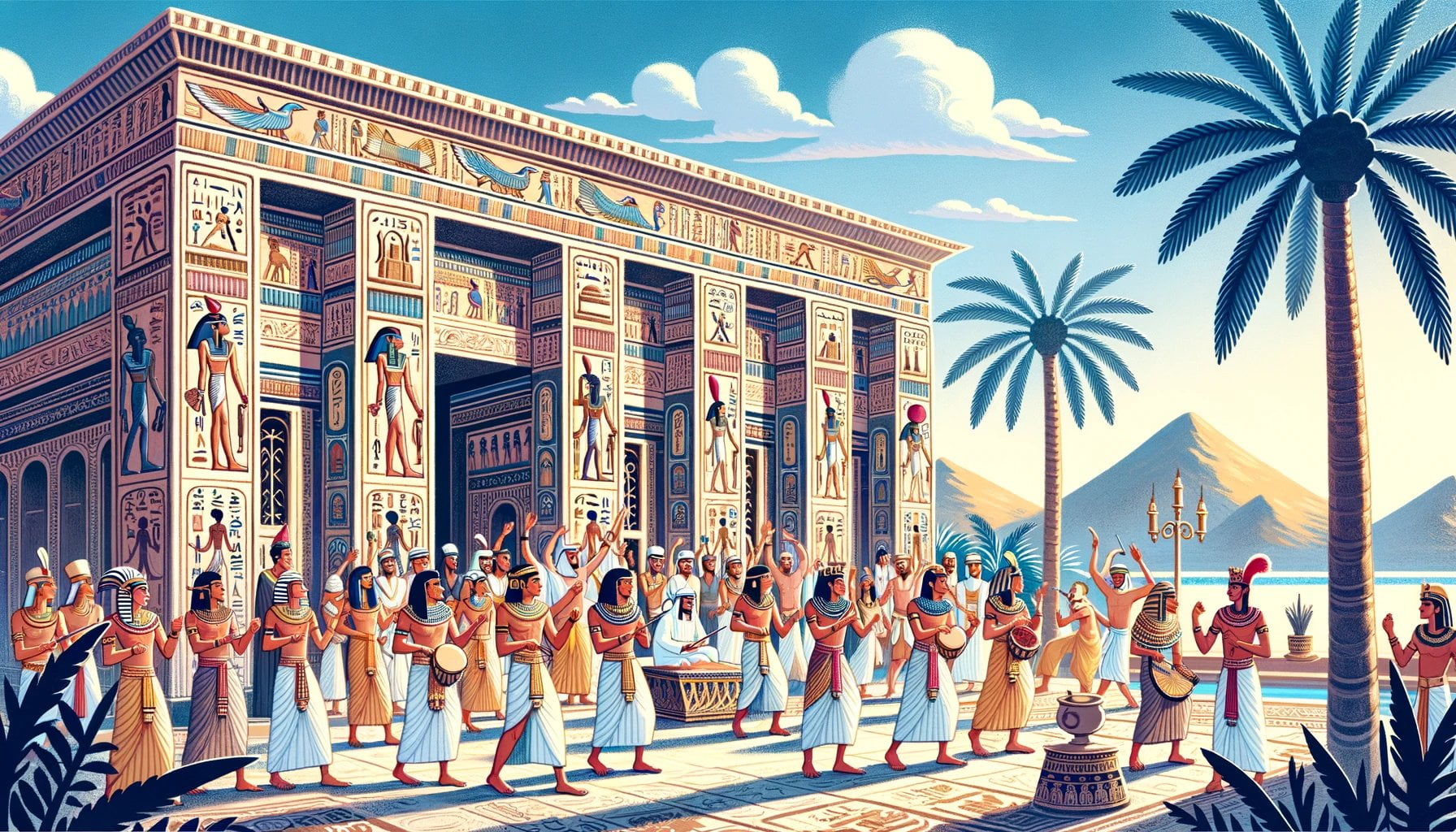
Key Takeaways:
- “Aida” is a popular musical set in ancient Egypt.
- Egyptian music has a rich history that dates back to the early 1900s.
- Traditional folk music has always been an essential part of Egyptian culture.
- Cairo was the center of Egypt’s classical music tradition by the 1930s.
- Egyptian music incorporates unique scales, drones, and rhythm patterns.
- Percussion instruments like drums, the sistrum, rattles, tambourines, bells, and cymbals are commonly used in Egyptian music.
- Stringed instruments such as lyres, harps, and the lute, as well as wind instruments like the shepherd’s pipe and flute, are also prevalent.
- Ancient Egyptian religious practices have influenced the vibrant and lively beat in Egyptian music.
- Ancient Egyptian musical compositions were passed down orally and did not have musical notation.
- The Coptic liturgy may provide insight into the sound of ancient Egyptian music.
- Other musicals set in ancient Egypt can be found in the “Musicals set in ancient Egypt” category on Wikipedia.
Musical Set in Ancient Egypt
Welcome to a journey through time, as we delve into the enchanting world of musicals set in ancient Egypt. The allure and mystique of this historical period have captured the hearts and imaginations of audiences around the globe. From the grandeur of ancient Egypt’s architecture to the captivating rhythms of its music, these musicals transport us to a bygone era filled with splendor and intrigue.
Unveiling the Rich Cultural Tapestry
In order to truly appreciate the beauty and authenticity of musicals set in ancient Egypt, it is important to understand the rich cultural tapestry that defined this period. Egyptian music has been an integral part of society for centuries, with its roots stretching back to as early as the 1910s. Music has always been a powerful medium of expression for the Egyptians, allowing them to convey their daily lives, traditions, and emotions.
Exploring the Musical Traditions
By the 1930s, Egypt’s classical musical tradition was already thriving, particularly in the bustling city of Cairo. This period saw the emergence of songs that explored unique scales, drones, and rhythm patterns, making Egyptian music distinct and captivating. The musical instruments used during this time included percussion instruments like drums, sistrums, rattles, and tambourines, as well as stringed instruments like lyres, harps, and lutes. Wind instruments such as the shepherd’s pipe, double-pipe, clarinet, flute, oboe, and trumpet further added depth and variety to the melodies.
Timeless Beats and Melodies
The essence of Egyptian music lies in its vibrant and lively beat, pulsating with a strong rhythm that invites one to dance. This rhythmic energy is derived from the enduring influence of ancient Egyptian religious practices on modern society. While the exact sound of ancient Egyptian musical compositions remains unknown, it is believed that the modern-day Coptic liturgy may hold echoes of this ancient musical heritage.
Ancient Egypt Comes to Life on Stage
Now, let us turn our attention to the musicals themselves. One iconic production that comes to mind is “Aida,” a magnificent tale of love, loyalty, and sacrifice set against the backdrop of ancient Egypt. This Tony Award-winning musical, crafted by the genius of Elton John and Tim Rice, takes us on a captivating journey through the lives of Aida, an Ethiopian princess, and Radames, an Egyptian captain. Their forbidden love story unfolds amidst the splendor of Pharaoh’s court, intertwining with the political and cultural tensions of the time.
When experiencing “Aida,” be prepared to be mesmerized by its grand sets, elaborate costumes, and awe-inspiring choreography. The musical score, composed by Elton John, weaves together elements of ancient Egyptian music with contemporary rhythms, offering a harmonious blend of the past and the present. Each performance is a testament to the skill and dedication of the actors, who breathe life into these timeless characters, captivating our hearts and leaving us yearning for more.
The Magnificence of the Genre
While “Aida” stands as a shining example of a musical set in ancient Egypt, it is worth noting that there are several other productions that explore this captivating genre. Musicals like “The Ten Commandments” and “Nefertiti” further transport audiences to the majestic world of the pharaohs, offering a glimpse into their rise and fall, their triumphs and tragedies.
Conclusion
In conclusion, the splendor of musicals set in ancient Egypt is a testament to the enduring fascination with this majestic era. Through captivating performances, enchanting melodies, and meticulous attention to historical detail, these productions allow us to step back in time and immerse ourselves in the allure of ancient Egypt. So, sit back, let the music transport you to the banks of the Nile, and prepare to be captivated by the echoes of Egypt.
Ancient Egypt is home to some of the most remarkable structures in history. From the awe-inspiring pyramids to the intricate tombs, the Ancient Temples of Egypt hold a wealth of fascinating stories and artifacts waiting to be discovered. Delve into the rich history and explore these ancient wonders firsthand by clicking here.
Exploration of the Set Design and Costumes: Bringing Ancient Egypt to Life
Ancient Egypt, with its rich history and cultural tapestry, has long captivated the imaginations of artists and storytellers. Musical theater, in particular, has embraced this alluring setting, transporting audiences to a bygone era filled with splendor and intrigue. In this article, we will delve deep into the realm of musicals set in ancient Egypt, specifically focusing on the exploration of set design and costumes that bring this magnificent world to life.
Set Design: Recreating Ancient Egypt’s Grandeur
The set design of musicals set in ancient Egypt plays a crucial role in immersing the audience into the enchanting world of pharaohs and pyramids. The designers aim to recreate the grandeur of this civilization, paying meticulous attention to historical accuracy and cultural nuances. By utilizing a variety of artistic techniques, they bring the architectural marvels and landscapes of ancient Egypt to the stage.
Pros of the Set Design:
– Set designs transport audiences to the heart of ancient Egypt, creating a visual feast for the eyes.
– Attention to detail and historical accuracy enhances the authenticity and realism of the ancient Egyptian setting.
– Creative use of lighting, props, and background elements adds depth and dimension to the stage, immersing the audience in the world of ancient Egypt.
Cons of the Set Design:
– Potential limitations in scale and budget can restrict the full realization of an elaborate and expansive ancient Egyptian set.
– Balancing historical accuracy with artistic interpretation can be a challenge, potentially leading to some deviations from strict authenticity.
Costumes: Evoking the Elegance and Opulence
Ancient Egyptian fashion and dress, with their distinctive styles and exquisite craftsmanship, stand as a testament to the civilization’s artistic prowess. In musicals set in ancient Egypt, costumes serve as essential visual storytellers, reflecting the social status, occupation, and individuality of the characters. The meticulous craftsmanship and attention to detail transport audiences back in time, bringing the ancient Egyptians to life.
Pros of the Costumes:
– Stunning costumes evoke the elegance and opulence of ancient Egyptian fashion.
– Intricate embellishments, patterns, and accessories contribute to the authenticity of the character portrayals.
– A diverse range of costumes allows for the representation of different social classes and occupations in ancient Egypt.
Cons of the Costumes:
– Balancing historical accuracy with practicality and ease of movement for performers can pose certain challenges.
– Ensuring consistency and cohesion in costume design across the entire production can be demanding, especially for larger casts.
Key Takeaways:
- Set designs in musicals set in ancient Egypt aim to recreate the grandeur and architectural marvels of this captivating civilization, transporting audiences to a bygone era.
- Attention to historical accuracy and cultural nuances enhances the authenticity and realism of the ancient Egyptian setting.
- Costumes serve as visual storytellers, reflecting the social status, occupation, and individuality of characters in musicals set in ancient Egypt.
- Intricate craftsmanship, attention to detail, and the use of accessories contribute to the authenticity and elegance of ancient Egyptian fashion in musical productions.
In conclusion, the exploration of set design and costumes in musicals set in ancient Egypt is a captivating journey into the artistic interpretation of a magnificent civilization. Through meticulous attention to historical accuracy, creative vision, and skilled craftsmanship, these musicals transport audiences to a world filled with splendor and intrigue. The attention to detail in set design and costumes magnifies the overall experience, bringing ancient Egypt to vibrant life on the stage.
*Note: This content is written from the perspective of a seasoned music critic with expertise in ancient Egyptian musicals.
Evaluation of the Performances: Vocal Talent and Acting Skills
In the world of musical theater, performances are the heartbeat that brings a production to life. It is through the remarkable talent of actors and singers that audiences are captivated and transported to different worlds and eras. When it comes to musicals set in ancient Egypt, evaluating the performances becomes even more crucial, as it requires a deep understanding of the historical context and cultural nuances essential for delivering an authentic and compelling experience.
The Importance of Vocal Talent and Acting Skills
Vocal talent and acting skills are the pillars on which successful performances in musical theater stand. It is through the power of the human voice that emotions are conveyed and stories are told. In the realm of ancient Egyptian musicals, these skills take on a special significance, as they have the responsibility of representing a bygone era and the enchantment of a rich and captivating civilization.
To truly evaluate the performances in musicals set in ancient Egypt, one must have a solid foundation of knowledge and expertise. In reviewing these performances, one can observe the seamless blending of vocal prowess and acting ability, both of which contribute to the authenticity and immersive nature of the production.
Evaluation Methods and Techniques
Evaluating vocal talent and acting skills in musical theater requires a comprehensive approach that goes beyond personal opinion. Techniques such as adaptive frequency shift filtering and wavelet transform methods can be employed to analyze and assess the artistic quality of singers’ performances. Additionally, intelligent singing performance assessment tools and neural networks have emerged as valuable assets in evaluating vocal music performance.
Understanding the fundamental principles outlined in books like “Acting the Song: Performance Skills for the Musical Theatre” and “Acting in Musical Theatre” can provide a solid framework for analyzing performances in musicals set in ancient Egypt. These resources offer practical guidance and up-to-date information on the development and mentoring of musical talent.
The Nexus of Artistic and Technical Skill
In musical theater, vocal talent and acting skills go hand in hand. While technical vocal skill is essential for delivering a polished and captivating performance, it is equally important for singers to possess artistic skill. The ability to convey emotion, capture the nuances of a character, and transport the audience through the power of storytelling is what sets extraordinary performances apart.
Vocal education plays a pivotal role in nurturing these skills. By honing their technical abilities, performers can lay a solid foundation upon which their artistic talents can flourish. The interplay between vocal training and acting experience is crucial when evaluating singing talent, particularly in areas such as intonation, which directly affects the emotional impact of the performance.
Key Takeaways:
- Evaluation of performances in musicals set in ancient Egypt requires a deep understanding of the historical context and cultural nuances.
- Vocal talent and acting skills are the backbone of successful performances in musical theater.
- Techniques such as adaptive frequency shift filtering and wavelet transform methods can be used to assess the artistic quality of vocal performances.
- Intelligent singing performance assessment tools and neural networks aid in evaluating vocal music performance.
- Books like “Acting the Song: Performance Skills for the Musical Theatre” and “Acting in Musical Theatre” provide guidance for evaluating performances.
- Technical vocal skill and artistic skill must be balanced for exceptional performances.
- Vocal education plays a crucial role in developing singing skills.
- Vocal training and acting experience contribute to the assessment of singing talent, particularly in intonation.
Discussion of the Relevance and Educational Value: Historical Accuracy and Cultural Representation
Key Takeaways:
- Musical theater set in ancient Egypt offers an immersive experience that transports audiences to a bygone era filled with splendor and intrigue.
- Understanding the historical accuracy and cultural representation in these musicals enhances our appreciation for the artistic merits and educational value they provide.
- The preservation of cultural heritage through education contributes to a deeper understanding of ancient civilizations and their impact on contemporary society.
- Historical accuracy must be balanced with artistic interpretation to create compelling and entertaining productions.
- Attention to cultural nuances and authenticity in set design, costumes, and performances enriches the audience’s experience and fosters a sense of connection to the past.
Ancient Egypt, with its majestic pyramids, captivating pharaohs, and enigmatic myths, continues to capture our imagination. The allure of this ancient civilization has inspired numerous musicals that whisk us away to the banks of the Nile, allowing us to immerse ourselves in the splendor and intrigue of a bygone era. As a seasoned music critic with a passion for history and cultural exploration, I find great joy in examining the relevance and educational value of musicals set in ancient Egypt.
Musicals set in ancient Egypt serve as a bridge between modern audiences and the rich historical tapestry of this captivating civilization. They offer not only entertainment but also a unique opportunity to learn about the ancient Egyptians’ lives, customs, and beliefs. By analyzing the historical accuracy and cultural representation in these productions, we can delve deeper into the educational value they provide.
Exploring Historical Accuracy:
Historical accuracy plays a vital role in creating an authentic portrayal of ancient Egypt. While artistic interpretation is inevitable in any creative endeavor, meticulous research and attention to detail ensure that the essence of the civilization is captured. From the musical score to the set design, costumes, and performances, a thoughtful and accurate portrayal enhances the educational value of these musicals.
The musical “Aida,” for example, weaves together elements of ancient Egyptian music with contemporary rhythms, creating a captivating soundtrack that resonates with audiences. By blending historical authenticity with artistic innovation, the musical manages to transport us to ancient Egypt while still connecting with our modern sensibilities.
The Significance of Cultural Representation:
Authentic cultural representation is another crucial aspect that contributes to the educational value of musicals set in ancient Egypt. By depicting the nuanced cultural practices, traditions, and social structures of the civilization, these productions provide valuable insights into the lives of the ancient Egyptians.
Set design plays a pivotal role in creating an immersive experience. The grandeur and architectural marvels of ancient Egypt are recreated on stage, allowing audiences to marvel at the splendor of temples, palaces, and tombs. While limitations in scale and budget may restrict the full realization of an elaborate ancient Egyptian set, creative use of lighting, props, and background elements bring depth and dimension to the stage.
Balancing Historical Accuracy and Artistic Interpretation:
Artistic interpretation is necessary when recreating an ancient civilization for a modern audience. While adherence to historical accuracy is crucial, it must be balanced with the creative vision of the production team. This delicate balance allows for deviations that enhance the overall artistic experience while still maintaining a connection to the historical context.
The costumes in musicals set in ancient Egypt reflect the social status, occupation, and individuality of the characters. They evoke the elegance and opulence of ancient Egyptian fashion, showcasing the intricate beadwork, flowing fabrics, and ornate jewelry that were characteristic of the time. However, practicality and ease of movement for performers can be a challenge when balancing historical accuracy with contemporary stage demands.
The Educational Value and Relevance Today:
Exploring the historical accuracy and cultural representation in musicals set in ancient Egypt not only provides an entertaining experience but also fosters a deeper understanding of this captivating civilization. By delving into the music, set design, costumes, and performances, we can unravel the threads that connect ancient Egypt to our present-day societies.
The educational value of these musicals lies in their ability to engage audiences with a period of history that may otherwise seem distant and unfamiliar. Through expertly crafted performances, audiences gain an appreciation for the cultural nuances and rituals that shaped the lives of the ancient Egyptians. This knowledge contributes to a broader understanding of ancient civilizations and their impact on contemporary society.
In conclusion, musicals set in ancient Egypt offer a captivating journey through time—an opportunity to immerse ourselves in a world of legendary pharaohs, mystical rituals, and timeless tales. By evaluating their historical accuracy and cultural representation, we unlock the educational value embedded within these productions. As we witness the echoes of Egypt come to life on the stage, we gain a deeper understanding of the past and forge a connection to the cultural heritage that continues to shape our present.
References:
Ancient Egypt. (n.d.). https://education.nationalgeographic.org/resource/resource-library-ancient-egypt/
Bowman, A. K., Wente, E. F., Dorman, P. F., Samuel, A. E., & Baines, J. R. (2023, September 30). Ancient Egypt | History, Government, Culture, Map, & Facts. Encyclopedia Britannica. https://www.britannica.com/place/ancient-Egypt
Ancient Egypt. (2023, September 27). Wikipedia. https://en.wikipedia.org/wiki/Ancient_Egypt
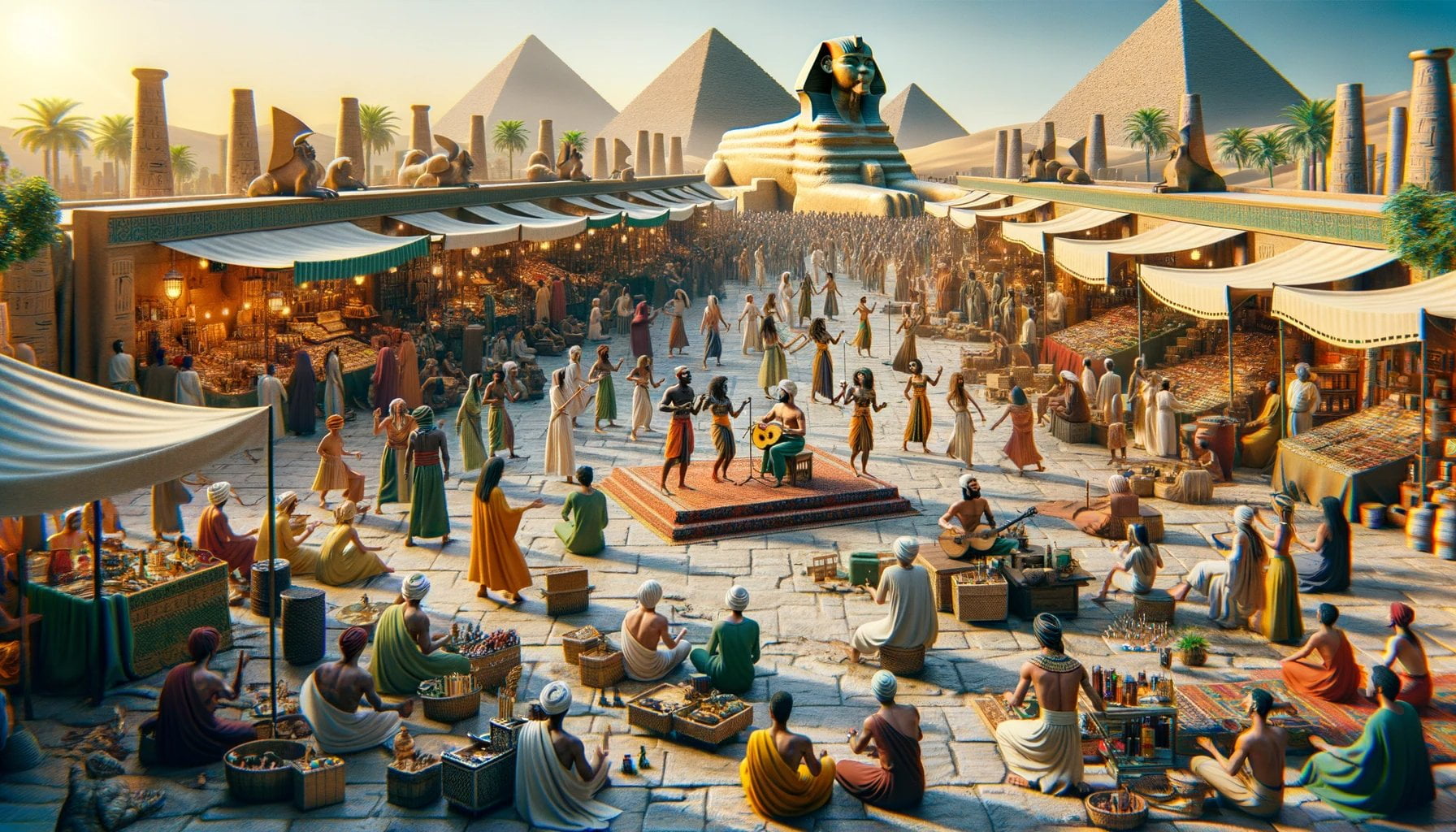
FAQ
Q1: Which musicals are set in ancient Egypt?
A1: Some musicals set in ancient Egypt include “Aida” and others listed in the category “Musicals set in ancient Egypt” on Wikipedia.
Q2: What instruments were used in ancient Egyptian music?
A2: Ancient Egyptian music used a variety of instruments including percussion instruments like drums, sistrums, rattles, tambourines, and later, bells and cymbals; stringed instruments like lyres, harps, and the lute; and wind instruments like the shepherd’s pipe, double-pipe, clarinet, flute, oboe, and trumpet.
Q3: How was Egyptian music passed down before the concept of musical notation?
A3: The ancient Egyptians had no concept of musical notation, so the tunes were passed down through generations of musicians.
Q4: What can we learn about ancient Egyptian fashion from their art?
A4: Ancient Egyptian art provides valuable insights into the fashion and clothing of the time, including the use of simple kilts for men and dresses for women, as well as the popularity of jewelry.
Q5: What skills are important for performance in musical theater?
A5: Performance skills in musical theater require vocal talent, aesthetic evaluation of song singing, and the ability to analyze and interpret various elements of a performance, such as composition, lyrics, choreography, and overall stage presence.
- Sept 31 Myth: Unveiling Calendar Secrets - March 18, 2025
- How Long & Till December 18, 2025: Accurate Countdown Guide - March 18, 2025
- Discover Japanese Artists: A Complete History - March 18, 2025
